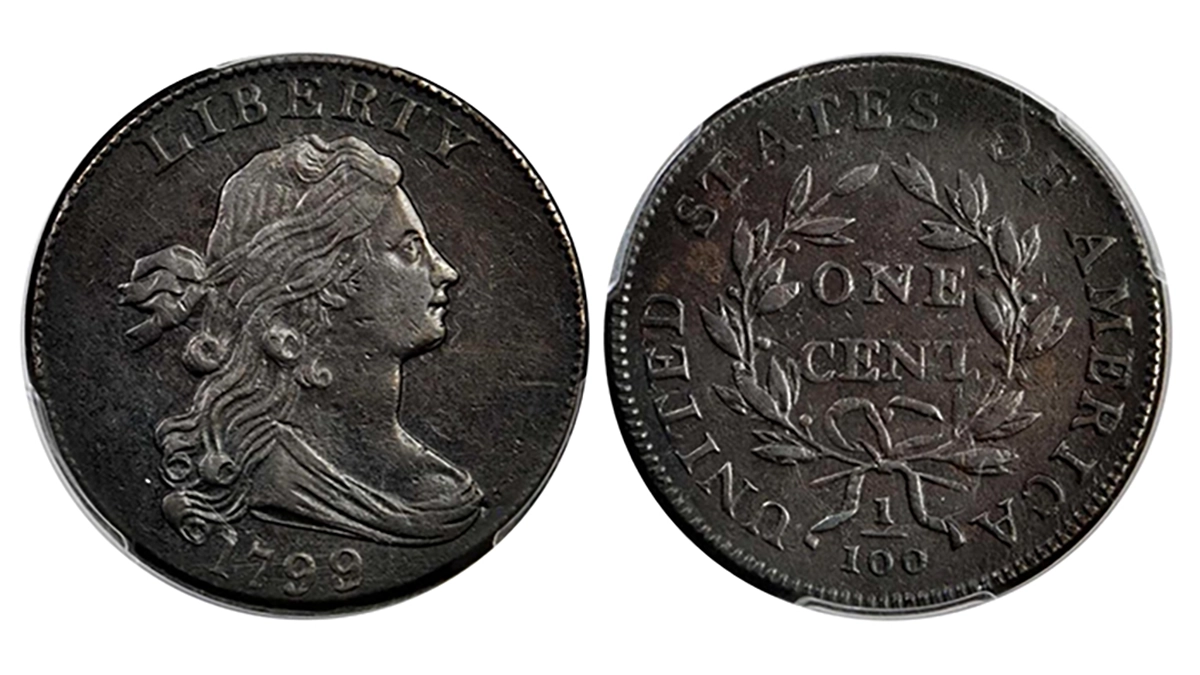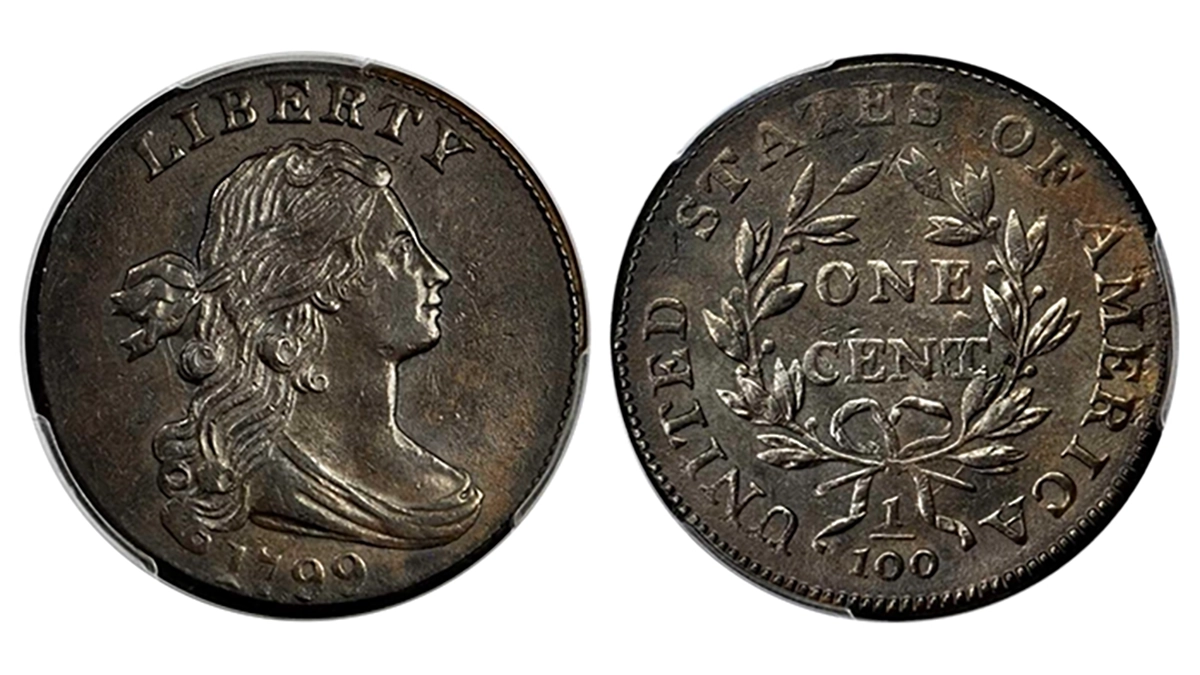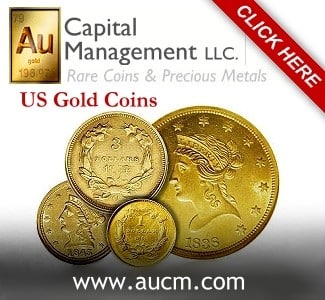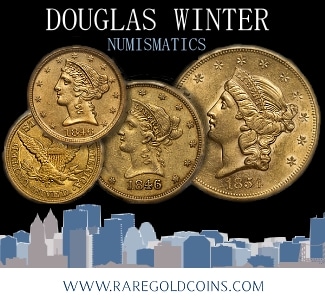
During the same year that the United States Mint finally became an independent government agency, answering directly to the president, it struck nearly one million large cents.
However, of the total issuance of 904,585 large cents in 1799, the vast majority were struck with old dies dated 1798. In fact, it is estimated that only around 42,540 true 1799 cents were struck. These coins, known by the reference number Sheldon-189, are scarce in all grades and a true conditional rarity in higher grades, with only one known Mint State example. The “true” 1799 cents were produced by only one of the three 1799 die parings.
As an aside, the remaining two die pairings display an interesting overdate, created when Mint workers reworked old obverse dies by cutting in the new date. Known as Sheldon-188, despite being struck by two die pairs instead of one, this variety is slightly rarer than the 1799 true date and represents a fraction of the 1799 issuance.
As with the prior year, a number of 1799 large cents were also struck in 1800. This is evidenced by the shared color characteristics between a number of 1799 and 1800 large cents.
These coins were heavily circulated, as the fledgling United States government fought to replace foreign currency that was still widely used across its economy. As such, by the time early U.S. coin collectors and numismatists realized the true rarity of this type in the mid-1800s, many examples existed only in low grades. Still, these early collectors were spending upwards of $25 for a “Common 1799” in the second half of the 19th century. Adjusted for inflation, this is worth upwards of $750 today. At that time, $25 was equal to roughly two weeks’ wages for a semi-skilled laborer!
The 1799 Large Cent in Today’s Market
As one of the true rarities in the U.S. large cent series, the 1799 type is relatively hard to acquire and commands a premium price over other types in nearly all grades. So great is the value of this type that in 2021, a Poor 01 (!) 1799/8 variety sold for $1,320 in Heritage Auctions’ internet sale #132149. While it could be argued that this high price was due to the extremely low grade, there are a number of collectors who focus on so-called slicks. However, other examples in relatively low grades have sold for nearly $20,000. For example, Stack’s Bowers sold a piece with glossy surfaces that displays medium brown surfaces infused with slight olive highlights that PCGS graded as Fine 12 for $19,200 in their 2021 ANA Auction.
Demand for this type in medium-to-high grade will probably always outstrip supply, and the price begins to skyrocket for examples in VF 30 and above. Heritage Auction even recorded a price of $56,400 for an S-189 graded as VF 30 in their January 2022 FUN sale. Prices hit six figures between VF 35 and EF 45, with pieces selling for between $100,000 and $161,000 in this range. In a seemingly anomalous sale, Heritage sold an AU 50 S-189 with a strong LIBERTY and date for only $15,275. Even more surprisingly, this coin was pedigreed to both the Eric P. Newman and “Colonel” E.H.R. Green collections.
Capping off both the grading and price scales for this type is an MS 62 that was found by an unidentified collector in the stock of London dealer A.H. Baldwin and Sons in the late 1920s (around 1928) and later sold in Boston to American Numismatic Association official Frank H. Shumway. After passing through numerous hands during the intervening years, it was sold again in September 2009 by Goldberg Auctioneers to D. Brent Pogue for just under $1 million.
However, when it was sold again in 2017 by Stacks Bowers, it brought in only $540,500.
* * *
Market Data and Noteworthy Specimens
1799/8 Draped Bust Cent, Sheldon-188

Rarity-4. More frequently encountered of the two 1799/8 varieties. The other, NC-1, is prohibitively rare an unknown in mid-range circulated grades or higher.
- PCGS XF45 #32219413: E.F. Kuithan, Esq. Collection; “The E.F. Kuithan Collection”, Ed. Frossard, June 1883, Lot 255; T. Harrison Garrett Collection, via George Massamore; Robert and John Work Garrett, by descent, 1888; Robert Garrett interest to John Work Garrett, 1919; transfer completed, 1921; John Work Garrett to the Johns Hopkins University, by gift, 1942; “The Garrett Collection, Part I”, Bowers and Ruddy, November 1979, Lot 92 – $4,200; Denis W. Loring; Norman W. Pullen, by sale, March 1980; George Cores Collection, by sale, April 1981; Thomas Reynolds; Denis W. Loring, by sale, July 1993, via Robert W. Everett; Allan Kollar Collection, by sale, October 1994; Superior Galleries and McCawley/ Grellman, May 2005, Lot 1020; Daniel W. Holmes, Jr. Collection; “The Dan Holmes Collection”, Part I”, Ira and Larry Goldberg Coins and Collectibles, September 2009, Lot 349; D. Brent Pogue Family. As PCGS XF45 #32219413. Stack’s Bowers / Sotheby’s, March 31, 2017, Lot 5111 – $164,500. Pedigree research assisted by Stack’s Bowers.
- PCGS XF40 #41069316: Dr. George P. French; “The Dr. George P. French Collection”, B. Max Mehl 1929 Fixed Price List, Lot 232 – $650; Henry A. Sternberg, purchased August 1930; T. James Clarke in 1944; B. Max Mehl; R.E. “Ted” Naftzger, Jr.; Abe Kosoff, August 1958, Lot 518 – $910; R.E. “Ted” Naftzger, Jr.; “The James O. Sloss Collection”, Abe Kosoff, October 1959, Lot 49 – $850; R.E. “Ted” Naftzger, Jr.; “The Admiral Bitler Collection”, A-Mark Coin Co., March 1973, Lot 136 – $4,150; Abe Kosoff; Mike Kliman on August 8, 1983; “The Douglas F. Bird Collection”, Goldberg Auctions, February 2020, Lot 65; Heritage Auctions, January 14, 2022, Lot 4570 – $117,000.
- PCGS XF Detail – Repaired Rim #35626120: Dr. William H. Sheldon, 1936; Morton Stack; unknown intermediaries; Harmer Rooke, August 1970, Lot 200; William T. Anton, Jr.; Joe Flynn Rare Coins; John R. “Bob” Grellman, July 1976; Denis W. Loring. March 1985; “The Jack H. Robinson Collection”, Superior Galleries, January 1989, Lot 395; Denis W. Loring, June 1991; Dr. Eugene Sherman; Bowers and Merena, October 2000, Lot 119. As PCGS VF35 #13457183. “The Walter J. Husak Collection”, Heritage Auctions, February 15, 2008, Lot 2191 – $48,875. Husak Collection on insert; Jon A. Boka.; As PCGS XF Detail – Repaired Rim #35626120. “The Thaddeus A. Tatum III Collection”, Stack’s Bowers, August 15, 2018, Lot 1035 – $14,400. EAC VF25 (per Bland and Breen); Bland CC#5, Breen CC#3; Noyes VF20, CC#6 (tied), repair at 2 o’clock on obverse, die cracks around ribbon and fraction bar on reverse. Clashed dies.
- PCGS VF30 #81370151: S.H. Chapman, October 1910, Lot 602; (per Heritage, probably) Major Richard Lambert; unknown intermediaries; Bowers and Merena November 1986, Lot 2388; Joel Spingarn, via Robert W. Everett, May 5, 1993; “The Allan Kollar Collection”, Superior Galleries, May 2005, Lot 1021; unknown intermediaries; “The Joseph C. Thomas Collection”, Heritage Auctions, April 2009, Lot 2039; “The Haig Koshkarian Collection”, Goldberg Auctions, February 2017, Lot 31; “The Arizona Collection”, Heritage Auctions, January 12, 2022, Lot 3028 – $56,400.
- PCGS VF25 #4492288: “The William Cutler Atwater Collection”, B. Max Mehl, June 11, 1946, Lot 25 – $237.50; Louis E. Eliasberg, Sr.; “The Louis E. Eliasberg, Sr. Collection”, Bowers and Merena, May 1996, Lot 509; Stack’s, July 30, 2009, Lot 123 – $31,625; “The Adam Mervis Large Cent Collection”, Heritage Auctions, January 10, 2014, Lot 2699 – $70,500; “The Arizona Collection”, Heritage Auctions, January 12, 2022, Lot 3027 – $52,800. Diagonal hit just above Liberty’s bust. Gouge below bust truncation to the right of the second 9.
- PCGS VF20 #21535130: “The Lindesmith Collection”, New Netherlands Sale #50, April 1957, Lot 1121; possibly to Bebee Stamp and Coin; Tom Reynolds; Harry Laibstain, Baltimore, 2003. As PCGS VF20 #21535130. “The ESM Collection”, Stack’s Bowers, August 6, 2020, Lot 1031 – $36,000.
- NGC EF Details – Corrosion: Stack’s Bowers, August 7, 2012, Lot 11190 – $13,500 Reserve Not Met. Late die state, pitted, green.
1799 Draped Bust Cent, Sheldon-189

Rarity-2+. Obverse 2. Reverse C. Date spaced 1 7 99. Normal date.
- PCGS MS61 #15656357: Discovered in England before 1928; A.H. Baldwin & Sons, Ltd.; unknown American numismatist; Frank Shumway, by trade, ca. 1928; Elmer Sears; Henry C. Hines Collection, by sale, via Wayte Raymond, October 1928; Carl Wurtzbach; Dr. William H. Sheldon; Sheraton Coin Company; “The Dr. James O. Sloss Collection”, by sale, 1948; “The R.E. “Ted” Naftzger, Jr. Collection”, by sale, en bloc, September 1958; “The Dr. James O. Sloss Collection”, Abe Kosoff, October 1959, Lot 50 – $10,600; “The R.E. “Ted” Naftzger, Jr. Collection”; Eric Streiner, by sale, en bloc, via Stack’s, February 1992; Jay Parrino; “The W.M. “Jack” Wadlington Collection”, by sale, April 1996; “The Daniel W. Holmes Jr. Collection”, by sale, via Bob Grellman and Chris McCawley, November 2005; “The Dan Holmes Collection, Part I”, Ira and Larry Goldberg Coin and Collectibles, September 2009, Lot 352, via Larry Hanks. D. Brent Pogue Family. As PCGS MS61 #15656357. “The D. Brent Pogue Family Collection, Part V”, March 31, 2017, Lot 5112 – $540,500. Pedigree research assisted by Stack’s Bowers.
- PCGS XF45 #13457184: Purchased from a countryman for $2 by C. Rogers, circa 1845 – $25; Lorenzo H. Abbey; W. Elliot Woodward, October 1864, Lot 628 – $32.50; Robert B. Chambers; W. Elliot Woodward, February 1866, Lot 575 – $27; Colin Lightbody; Edward Cogan, December 1866, Lot 553 – $45; Mortimer L. Mackenzie; Edward Cogan, June 1869, Lot 636 – $55; E. Harrison Sanford; Edward Cogan, November 1874, Lot 260 – $67.50; Richard B. Winsor; S.H. & H. Chapman, December 1895, Lot 863 – $125; George H. Earle, Jr.; Henry Chapman, June 1912, Lot 3415 – $85; Clarence C. Bement; Henry Chapman, May 1916, Lot 308 – $160; Fred E. Joy; B. Max Mehl; Col. E.H.R. Green; B.G. Johnson; Stack’s, privately; “The Oscar J. Pearl Collection”, Numismatic Gallery, 1944 Fixed Price List, Lot 139 – $900; Harry J. Stein; Max L. Kaplan; C. Douglas Smith, 1952; Thomas Warfield via New Netherlands, February 1953 – $1,150; “The Louis E. Eliasberg, Sr. Collection”, Bowers and Merena, May 1996, Lot 510 – $46,200. As PCGS XF45 #13457184. “The Walter J. Husak Collection”, Heritage Auctions, February 15, 2008, Lot 2192 – $161,000. Husak Collection on insert. Pedigree research assisted by Heritage Auctions.
- PCGS Genuine – Environmental Damage XF Details #83600354: John K. Curtis; Bangs, Merwin & Co., June 1859, Lot 140 – $11; Joseph J. Mickley, April 30, 1867; W. Elliot Woodward October 1867, Lot 1975 – $32; Benjamin Betts; Jamison Brevoort; Lorin G. Parmelee; W.H. Strobridge, June 1876, Lot 1765 – $16.50; “The M.A. Brown Collection”, S.H. and H. Chapman, April 1897, Lot 784 – $160; Ed. Frossard; H.P. Martin; Dr. Thomas Hall, September 7, 1909; Virgil Brand; B.G. Johnson, September 27, 1943; Abe Kosoff; James G. Macallister; “The Milton Holmes Collection”, Stack’s, October 1960, Lot 1415 – $950; Lelan Rogers; Lester Merkin, November 1965, Lot 57 – $3,100; “The Lelan Rogers Collection”, Stack’s, November 1995, Lot 1028 – $13,200. As NGC AU Details #3607723-014. “The Eugene H. Gardner Collection, Part III”, Heritage Auctions, May 12, 2015, Lot 98017 – $73,437.50; As PCGS Genuine – XF Details #83600354. Heritage Auctions, April 27, 2017, Lot 4007 – $42,300. Pedigree research assisted by Heritage Auctions.
- PCGS VF35 CAC #16814888: As PCGS VF35 #16814888. Heritage Auctions, March 25, 2010, Lot 112 – $48,875. As PCGS VF35 CAC #16814888. The Cardinal Collection Educational Foundation; “The Cardinal Collection”, Stack’s Bowers, January 22, 2013, Lot 13011 – $99,875. CAC added. Dark spot to the immediate left of Liberty’s second lowest curl. Small gouge to the upper left of the ribbon.
- PCGS VF30 #05411680: “The Peter Mougey Collection”, Thomas Elder, September 1910, Lot 41; “The Norweb Collection, Part III”, Bowers and Merena, November 1988, Lot 2782. As PCGS VF30 #05411680. “The Joshua and Ally Walsh Collection of United States Cents”, Heritage Auctions, January 2006, Lot 3026 – $48,875. Joshua and Ally Walsh Collection on insert. “The ESM Collection”, Stack’s Bowers, August 6, 2020, Lot 1032 – $48,000.
- PCGS VF30 CAC #25242174: As PCGS VF25 CAC #10945246. Heritage Auctions, January 6, 2011, Lot 5423 – $24,600. Heritage Auctions, July 11, 2013, Lot 3035 – $25,850. Hesselgesser on insert. As PCGS VF30 #25242174. Stack’s Bowers, March 2015, Lot 6009 – $32,900. Upgraded to VF30. CAC approved at the new level. Hesselgesser pedigree removed. Myriad dark splotches on the obverse.
- PCGS VF30 #07119743: S.H. Chapman, October 1910, Lot 602; Later, Bowers and Merena, November 1986, Lot 2833; Joel Spingarn, via Robert W. Everett; Allen J. Kollar; Superior, May 2005, Lot 1021. As PCGS VF30 #07119743. “The Joseph C. Thomas Collection”, Heritage Auctions, April 30, 2009, Lot 2039 – $69,000.
- PCGS VF25 #16999612: New York Stamp & Coin Co., January 1890, Lot 2540; Ropes Collection; New York Stamp & Coin Co., December 1893; Wayte Raymond; New Netherlands Coin Co., 1953, Lot 269; William H. Sheldon; “The R.E. ‘Ted’ Naftzger, Jr. Collection”, New Netherlands, November 1973, Lot 505. As NGC VF25. Col. Steven Ellsworth discussed this 1799 cent in the CoinWeek Cool Coins! video (Episode #6), above. As PCGS VF25 #16999612. “The Colonel Steve Ellsworth Die State Collection”, Heritage Auctions, September 26, 2013, Lot 4728 – $32,900. Ropes-Levine-Ellsworth on insert. Pedigree research assisted by Heritage Auctions.
- PCGS VF25 #06696188: Heritage Auctions, September 10, 2009, Lot 55 – $25,300.
- PCGS VF25 CAC #50000613: Anthony Terranova, February 2001; Heritage Auctions, January 8, 2009, Lot 3589 – $25,300.
* * *
Design
Obverse:
The obverse design of the Draped Bust cent is dominated, like many early American coins, by the bust of a right-facing Lady Liberty. Her hair is depicted blowing in the wind, the motion complemented by the bow holding Liberty’s hair back from her face. Liberty’s chest is “draped” with fabric that resembles a classical revival version of an ancient toga. The legend LIBERTY is engraved atop the bust and the date (1799) can be seen at the bottom of the coin, with the fields mostly left blank. While faint, and sometimes not visible, both sides of the cent have denticled borders.
Reverse:
As with all early large cent types, the reverse design of the 1799 Draped Bust cent is centered on the written denomination, ONE CENT. The denomination is surrounded by a laurel wreath with five berries on each branch. The two halves of the wreath are tied together in a large decorative knot by a ribbon. Additionally, in this style, the ends of the wreath point downwards. The wreath is surrounded by the legend “UNITED STATES OF AMERICA”. Underneath the wreath and between the two tails of the bow is the fractional denomination “1/100”, which stands for one-hundredth of a dollar.
Edge:
The edge of the 1799 Draped Bust large cent is plain or smooth, without reeding or edge lettering.
Designer
Robert Scot was the second engraver employed by the United States Mint and served as its first Chief Engraver from 1793 to 1823. Born in England in 1744, Scot immigrated to the United States in 1775, first settling in Fredericksburg, Virginia. He moved to Philadelphia around 1783, where he produced portraits for the Rees Encyclopedia. He received an appointment at the Mint on November 23, 1793, where he got to work producing designs for the cent. Initially known for his banknote engravings, Scot developed the Draped Bust, Flowing Hair, and Turban Head gold coin designs. Scot died on November 1, 1823; he was succeeded as Chief Engraver by William Kneass.
Coin Specifications
| Country: | United States of America |
| Year Of Issue: | 1799 |
| Denomination: | One Cent (USD) |
| Mint Mark: | None (Philadelphia) |
| Mintage: | 42,540 (Estimated) |
| Alloy: | Copper |
| Weight: | 10.89 g |
| Diameter: | 29.00 mm |
| Edge: | Plain |
| OBV Designer | Robert Scot |
| REV Designer | Robert Scot |
| Quality: | Business Strike |
* * *
Sources
* * *




